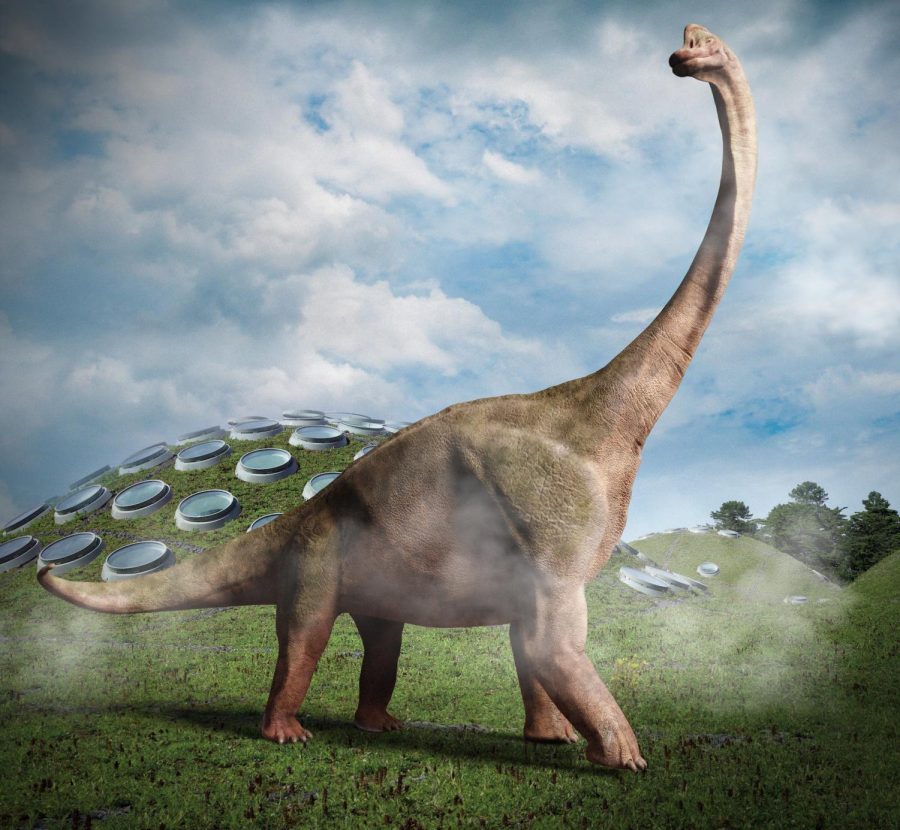The World’s Largest Dinosaurs exhibit opens May 26 at California Academy Of Sciences
SAN FRANCISCO, CA (April 13, 2023)—The World’s Largest Dinosaurs, a major exhibition on view at the California Academy of Sciences from May 26, 2023 to January 21, 2024, explores the amazing biology of a group of uniquely super-sized dinosaurs: the long-necked and long-tailed sauropods. Organized by the American Museum of Natural History (AMNH) in New York, the exhibition draws on paleo-biological research that looks in part to living organisms to make inferences about how these giants—some of which grew to be longer than 150 feet, or the length of four standard city buses—were able to thrive, as a group, for approximately 140 million years. Through imaginative exhibits—including the exhibition centerpiece, a life-size, detailed model of a 60-foot-long Mamenchisaurus—The World’s Largest Dinosaurs takes visitors deeper than just bones and into the bodies of these titans, shedding light on how heart rate, respiration, metabolism, and reproduction are linked to size.
Renowned paleontologist and Academy Executive Director Scott Sampson, PhD shares, “As a paleontologist, I’m thrilled that the Academy has this opportunity to share the latest insights about the biggest dinosaurs ever to walk the Earth. The World’s Largest Dinosaurs exhibition goes well beyond fossilized bones and teeth to explore these ancient giants as living, breathing creatures. From explorations of the pressure needed to pump blood all the way up those crazy-long necks, to understanding how much food was needed to maintain such incredible bulks, awed visitors will come away with a better understanding of how these super-sized beasts lived and thrived.”
Distinguished by their colossal size, sauropods included animals of diverse shape and ornamentation, such as the gigantic Apatosaurus, formerly known as Brontosaurus. Focusing on the biology and behavior of these diverse creatures, The World’s Largest Dinosaurs builds on a growing body of research that examines dinosaurs as living animals, primarily through comparisons with modern dinosaur relatives.
The exhibition is curated by Mark Norell, Curator Emeritus of the American Museum of Natural History’s Division of Paleontology, who has done groundbreaking work in the field of dinosaur biology, and features the work of exhibition guest co-curator Martin Sander from the University of Bonn in Germany. Sander has assembled a multi-disciplinary research team of experts in materials science, animal nutrition, sports medicine, biomechanics, and paleontology to address the intriguing question of what sauropods in particular were like as living animals and how they became so large.
In their research, both Norell and Sander look to the closest modern relatives of dinosaurs, such as birds and crocodiles, to make inferences about sauropod biology, and the exhibition includes an array of interactive exhibits and hands-on activities that offer visitors of all ages engaging opportunities to compare sauropods with living animals. For instance, visitors can compare sauropod teeth with those of modern plant-eaters and carnivores or use a hand pump to discover how much pressure would have been needed to distribute blood through a sauropod’s long neck to its head.
“This exhibition represents a new era of dinosaur research that leverages recent advances in technology and the expertise of multiple scientific disciplines to understand how the largest animals to ever roam the earth actually lived,” said curator Norell. “It demonstrates how our understanding of these enormous creatures continually evolves and changes in response to new science.”
“The question of sauropod biology, particularly their gigantic size and incredible longevity as a group has interested me for some time,” said Sander, guest co-curator. “This exhibition addresses this question through a multi-disciplinary research process that reconstructs the mysteries of sauropod life in vivid detail.”
Exhibition Sections
The World’s Largest Dinosaurs is divided into multiple content sections: Upon entering the exhibit, visitors will be greeted by the enormous head of an Argentinosaurus, considered the world’s largest sauropod, measuring up to 140 feet long and likely weighing up to 90 tons. Throughout the exhibit guests will explore the multidimensional creatures through a variety of lenses in multiple content sections:
-
Size. This section explores the biological effects of size in animals both huge and tiny and living and extinct. To provide perspective, a 15-foot-tall replica of a Supersaurus hind leg is displayed among models, specimens and bones of living animals such as a hummingbird, dwarf gecko, African elephant, and human.
-
Meet Mamenchisaurus. Standing 11 feet tall at the shoulders and measuring 60 feet long—approximately the size of a tractor-trailer—the centerpiece of this exhibition is a life-size, fleshed-out model of an 18-year-old female Mamenchisaurus. Though not the largest sauropod, Mamenchisaurus is known for its remarkable 30-foot-long neck, which accounts for half of its body size. Textured skin on one side of the model gives visitors a sense of this enormous animal’s appearance; on the other side the animal appears to be dissected, with key organs, including the heart and lung, isolated and modeled at life size. A video projected on the animal’s midsection enables visitors to see how a Mamenchisaurus’s respiratory, circulatory, and digestive systems contributed to its enormous size.
-
Eat. What did a sauropod eat? How could sauropods possibly get enough food to survive? This section addresses how sauropods developed into hugely efficient eating machines by exploring their “fermentation tank” digestive systems, their herbivorous diet, incisor-like teeth, and the mechanics of ingesting by swallowing vegetation whole.
-
React. Sauropods had small brains in their relatively small heads. An Apatosaurus brain weighed at most 4 ounces compared to the 48-ounce human brain. This section addresses brain size and debunks the “booster brain” myth, which hypothesized that some sauropods possessed a second “brain” in their tail bone. On display is a cast of half of a Diplodocus braincase, which provided scientists with important clues about the large-scale brain structure of this extinct dinosaur.
-
Reach. With their crane-like necks, sauropods were able to reach food that other plant eaters could not. This section addresses the biomechanics and adaptive advantages of a long but surprisingly lightweight neck. The intricate structure of sauropod vertebrae is illustrated by a huge cast fossil neck bone; also explored is the effectiveness of long necks as cooling systems.
-
How Big. Over the course of 140 million years, sauropods evolved into a range of shapes and sizes with varying colors and ornamentation. Through fossil evidence and the study of living animals, scientists have been able to determine the approximate sizes and weights of various species of sauropods. A 60-by-16-foot mural on one wall of the exhibition depicts this group’s diversity.
-
Babies. Emerging from an egg smaller than a soccer ball, hatchling sauropods grew to an enormous size in a short amount of time. While hatchlings generally weighed less than 11 pounds at birth, within three decades, mature adult sauropods could weigh 10,000 times more, or as much as 55 tons. No other known land animal, bird, or reptile grew at such an exponentially rapid rate. Replicas of eggs from living and extinct animals—an elephant bird, the sauropod Ampelosaurus, the theropod Oviraptor, an osprey, and a ruby-throated hummingbird—are available for visitors to compare and analyze.
-
Skin. For scientists today, fossilized skin impressions are the only record of what a sauropod’s skin may have looked like. From these impressions, we know that sauropod skin was almost certainly dry and warm, and because dinosaurs had no sweat glands in their skin, they did not perspire. They were covered with small, bumpy and knobby scales that protected the dinosaur’s body and prevented evaporation of water from inside. No sauropods had hair or feathers. On display is a cast osteoderm, or bony skin growth, of a titanosaur, part of a sauropod group that reached the largest sizes and lived between 65 and 71 million years ago.
-
Beat. Human hearts pump 6.5 quarts of blood throughout the body, whereas a Mamenchisaurus heart pumped 630 quarts of blood. Although no fossilized dinosaur hearts have been discovered, scientists have been able to determine the size and structure of a sauropod heart by studying their closest living relatives—ostriches and crocodilians. A life-size heart model is on display, and visitors can use a pump connected to a computer interactive to calculate the correct speed and pressure required to circulate blood throughout a sauropod’s large body.
-
Breathe. A resting human inhales one pint of air per breath, while a Mamenchisaurus took in about 174 pints. On display is a life-size replica of the enormous and complex breathing system that made that volume possible. To understand sauropod respiratory systems, scientists looked to the breathing and anatomy of birds and crocodilians. These comparisons indicated that the highly efficient lungs of sauropods received oxygen-rich air during inhalation as well as exhalation. This continuous flow enabled a sauropod to spend less energy on breathing.
-
Fuel. With a diet that may have included horsetails, ginkgos, conifers, and ferns, a Mamenchisaurus needed 100,000 calories per day to survive. In contrast, an adult human needs just 2,200 calories per day. A 5½-foot cube of foliage on display represents how much plant matter—approximately 1,000 pounds—a Mamenchisaurus ate in a single day. An hour’s worth of food is encased in a smaller plexiglass column, while an interactive exhibit invites visitors to “feed” a hungry sauropod.
-
Who was that dinosaur? Sauropod tracks, which can be found on nearly every continent, have provided some of the best information about the animals’ daily life.
-
Search. There is still more to understand about sauropods and more specimens to be found. A wire outline of a vertebra hints at the dimensions of what may have been the largest sauropod to ever walk the Earth, Amphicoelias. In 1878, well-known fossil hunter E.D. Cope published detailed drawings and measurements of the specimen, but the fossil itself has since been lost.
The World’s Largest Dinosaurs exhibit is generously supported by The Bernard Osher Foundation.










